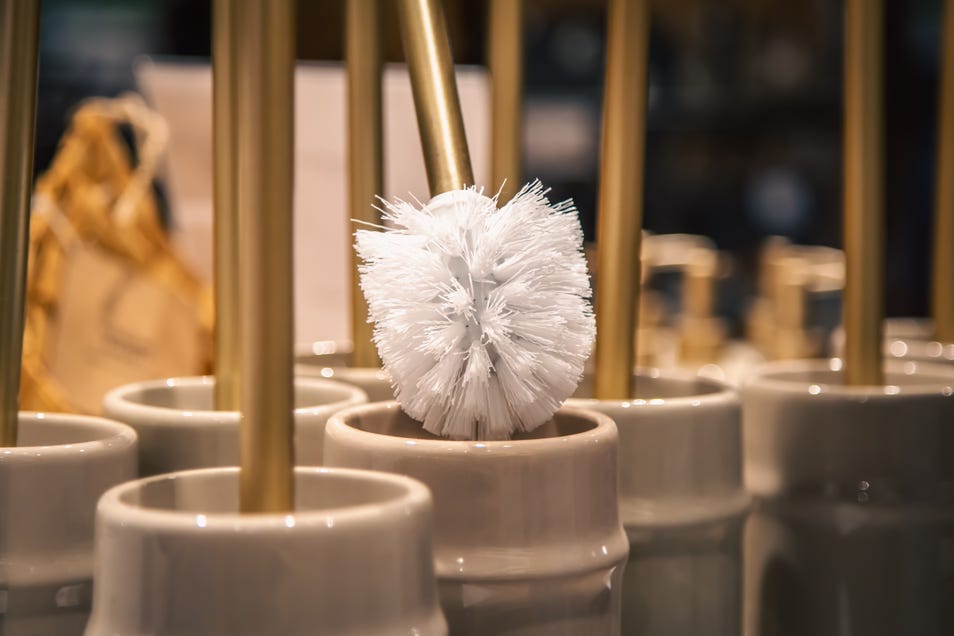How Often Should You Clean Your Toilet Brush?

Cleaning the toilet can seem daunting, especially when approached half-heartedly or with distractions in mind. This typically involves scrubbing the toilet bowl with a cleaning agent, wiping down exterior surfaces, and ensuring everything is free from stains, odors, and limescale.
We all do it because, at the end of the day, maintaining proper hygiene in the bathroom is important for a fresh and healthy living environment.
Out of all the various toilet cleaning tools, the toilet brush is the most important and effective for removing stains, dirt, and bacteria that can accumulate on the toilet bowl surface. But sadly, when it comes to maintaining its cleanliness, it is often overlooked!
Regularly cleaning your toilet brush is essential to prevent the buildup of bacteria and germs, ensure effective cleaning, and reduce the risk of cross-contamination.
So, while it might not be the most glamorous tool, read our article about “how often to clean toilet brush” to find the best practices for keeping your toilet brush clean and hygienic, ensuring optimal bathroom safety.
When should you clean toilet brushes
It's advisable to clean toilet brushes after every use to prevent germs from accumulating in the toilet bowl. For ideal hygiene, it's highly recommended to stick to a weekly bathroom cleaning regimen.
Ensuring your toilet brush gets a deep cleaning every week is essential for promoting a healthy living environment. Regular cleaning of the toilet brush helps maintain proper hygiene and prevents the spread of bacteria and germs in the bathroom environment.
Using a powerful cleaner like Harpic PowerPlus Original can help effectively remove the toughest stains. It kills 99.9% of bacteria and viruses, ensuring a thorough cleaning process. It is one of the most powerful toilet cleaners in the Harpic range. Incorporating it into your cleaning routine will not only remove 100% of limescale but leave the toilet freshening fragrance for a cleaner and more hygienic bathroom environment.
How often should you replace toilet brush
Toilet brushes should typically be replaced every six months when they show signs of wear and tear, such as frayed bristles, rust or deterioration of the handle, or an unpleasant odor that persists despite thorough cleaning using Harpic Bathroom Cleaner Citrus.
How can you effectively clean a toilet brush
To swiftly clean your toilet brush, follow the following steps:
Spray the toilet brush thoroughly with Bathroom Cleaner Trigger Spray and use a disinfectant wipe to clean the handle, ensuring all surfaces are covered.
Now, rinse the brush under hot water to remove any remaining debris and disinfectant residue left over.
Then, allow it to air dry completely. (Pro tip): Positioning it between the toilet seat and base can facilitate drying.
For deeper and more thorough cleaning, immerse the toilet brush in a solution made up of 1.5 capsful of Harpic Bathroom Cleaner Citrus and water (4 cups), ensuring all bristles are submerged for effective cleaning and disinfection.
FAQs
What are the signs that indicate my toilet brush needs cleaning?
Some of the most common signs that indicate toilet brush cleaning include foul odors emanating from the brush, visible residue buildup on the bristles of your brush, and discoloration of the brush itself.
Are there any maintenance tips to keep my toilet brush clean?
Keep your toilet brush clean by following the tips below:
Rinse it thoroughly after each use to remove any lingering residue.
Regularly soak the brush in a mixture of 1.5 capsful of Harpic Bathroom Cleaner Citrus and water (4 cups) to disinfect and remove bacteria.
Use a dedicated sponge solely for toilet cleaning to prevent cross-contamination with other areas of the home.
Is there a difference between cleaning a traditional toilet brush and a silicone toilet brush?
Yes, there are differences between cleaning a traditional toilet brush and a silicone toilet brush. Traditional brushes may trap bacteria in bristles, while silicone brushes are often more resistant to bacterial growth and easier to clean. Meanwhile, both require regular maintenance for effective use.
.png?width=70&height=88&format=png&quality=50)